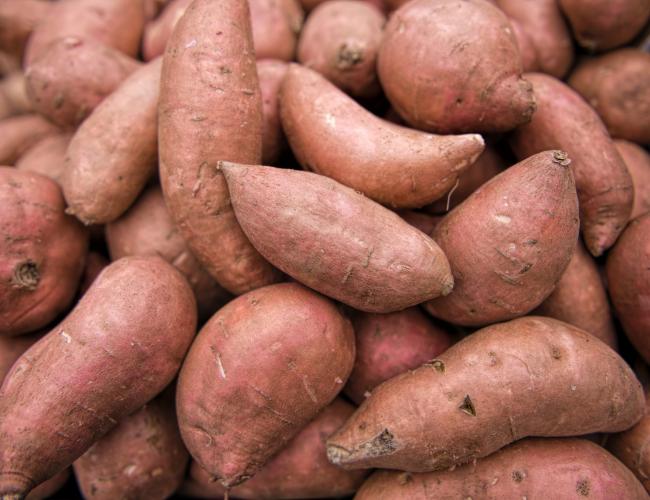It may not feel like it outside quite yet, but spring has arrived and with it the days of dreaming about what to plant in the garden this year! With winter storage crops running out and some spring veggies not available quite yet, sweet potatoes are a saving grace in April.

Growing Sweet Potatoes in Michigan
Sweet potatoes are started from young plants, called “slips” that are grown from the root of the potato. You can start your own slips at home by suspending a healthy root, pointed side up, in a glass of water for several weeks. When new growth reaches about 3 inches, the plants can be planted in soil or in a pot for future transplanting. Some store-bought potatoes are treated with sprout-inhibitors, so you’ll want to make sure that any roots you use aren’t from a treated potato.
Once in the garden, the plants will need frost protection if they are planted early. Sweet potato roots grow very deep, so the plants require little water once established. Potatoes should be harvested when the edible portion, the root, is about 6 inches in length and 2 inches in diameter. They should be harvested before a killing frost, as the roots will quickly rot once the vines are dead. If storing the sweet potatoes, they must be “cured” for five to ten days in high heat and humidity and then can be stored for up to a year in cool, humid conditions. Learn more about growing sweet potatoes with MSU Extension.
“Beauregard” is the most common variety of sweet potato grown in Michigan, since it is well-adapted to cooler temperatures.
Sweet Potatoes Health Benefits
Sweet potatoes are an excellent source of fiber and a variety of vitamins and minerals. A serving of sweet potatoes contains over 700% of your daily Vitamin A needs, 65% of the daily recommended amount of Vitamin C and 50% of the daily recommended amount of Manganese (Source). Sweet potatoes also contain significant amounts of Vitamin B6 and Potassium. Orange varieties of sweet potatoes are also rich in beta-carotene, an antioxidant that gives sweet potatoes their bright color. Beta-carotene is converted in the body and helps form light-detecting receptors in the eyes.
How to Cook Sweet Potatoes
Sweet potatoes can be prepared in lots of simple, creative ways. Instead of traditional mashed potatoes, try maple mashed sweet potatoes. Give baked potatoes a twist with this Mediterranean baked sweet potato recipe, or make southern-style candied sweet potatoes on the stovetop! For dessert, try a sweet potato casserole with a yummy streusel topping.
How have you enjoyed sweet potatoes over the winter? And will you be adding some to your garden this spring?
Elizabeth Pearce is TLD’s Operations Assistant and is based in Ann Arbor. She loves sweet potatoes.
Check out our other Crop Spots!
